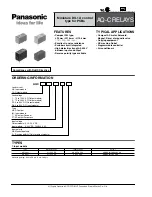
DUAL POLARI Z ED GROUND D I R ECTIONAL R ELAY
6. Circulate 5 amperes into "Terminal Blo ck "
4 out of 3, into 1 and out 2. Disco nnect the
voltage from terminals
7
and 8. The relay
should op erate.
7.
If the relay operated in 5, but not in 6, the
connections to "Terminal Blo ck " terminal s
3 and 4 are wrong and shoul d be r ever sed.
8. If rel ay op erated in 6 but not in 5 , the con
nections to 7 and 8 are r eversed and should
be changed.
9 . If the rel ay did not op erate in 5 or 6, the con
nections to "Terminal Block " terminal s 1
and 2 are wrong and should b e changed.
Phase Angl e Adj ustment: Fig.
8.
10. Turn the p hase shifter i n either direction
until the de voltage o utput between t erminal
2JB and 2JR in the front p anel j ust drop s to
zero, and read the p hase shifter angl e. ( angle
b etween I and
V).
1 1 . Continue the turning i n the s a1e direction
until the de voltmeter acro s s ack terminal
2JB and 2JR just r eads 20 ± 2 volts, and
read the angl e on the p hase shifter.
1 2. Adjust the potentiom eter 1 R 1 4 in front p anel
until the difference betw een the above angl es
becomes 180
±
2 degrees.
Zero Sen s i tivity Check:
13. Apply 1 20 volts and 10 amp eres a s indicated
above.
14. Check that the zero sensitivity angle occur s
within 4 degrees at 150° and 330° of the
p hase shifter.
Minimum P i ck Up Check: Fig.
8.
15. Apply 1 volt b etween terminal s
7
and 8
( 7
i s
pol arity) and ci rcul ate 0 . 4 amperes through
"Termi nal Block " terminals 1 and 2 ( 1 is
polarity). The rel ay should pick up at maxi
mum sensitivity (current lags 60°).
16. Disconnect the voltage termi nal
(7
and 8 )
and circulate 0 . 5 amp eres t hrough "Terminal
Block " terminal s 1 and 2 and through 4 and
3. The relay should op erate at 20 volts de
which is obtained between "Jack Termi nal "
2JR and 2JB. Al so check a 20 volts de out
p ut between "printed circuit bo ard" termin
al s 6 and 1 (6 i s po sitive).
B. Overcurrent Unit Adj ustment
Phas e Splitter Adj ustment
1 . Disconnect the directional amplifier circuit
board from the relay.
2. Extend mo dul e with board extender, and ad
j ust knob on rheo stat 3S1 ( front of modul e)
such that white pointer is equidistance from
each side of locking tab when S1 is fully
rotated.
3. Turn rheo stat 3S1 all the way towards lo west
dial current marking.
4. Circulate minimum current marked on t he
dial through terminals 1 and 2.
5. Co nnect scop e acro s s 3TP- 2 and printed cir
cuit terminal #1 ( ground). Adj ust potentio
m eter 3R 1 3 (middl e-top of board) to obtain
follo wing waveform:
Dial Cal i brati on
1. Apply rated de voltage to relay.
2. Connect high resistance de voltmeter to test
po ints on front of modul e . ( Red J = P a s.
Black J = Ne g . ) .
3. Apply de sired 3 S 1 current t o ' ' Terminal
Blo ck " 1 and 2.
4. Turn 3S1 rheostat until the rel ay op erates
as indicated by a sudden reading of appro x
imately 20 volt s de on m eter.
Dropout Adj u stment (3R l2)
1. Set Rheo stat 3S1 on minimum dial current
value, apply rated de voltage, and connect
the de voltmeter across "Jack Terminal JR
and JB " of overcurrent unit.
7
www
. ElectricalPartManuals
. com
Summary of Contents for KRD-4
Page 27: ...w w w E l e c t r i c a l P a r t M a n u a l s c o m ...
Page 108: ... w w w E l e c t r i c a l P a r t M a n u a l s c o m ...
Page 110: ...w w w E l e c t r i c a l P a r t M a n u a l s c o m ...
Page 112: ...w w w E l e c t r i c a l P a r t M a n u a l s c o m ...
Page 114: ...w w w E l e c t r i c a l P a r t M a n u a l s c o m ...
















































